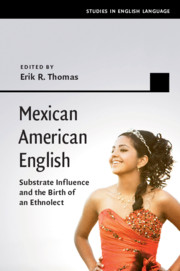Book contents
- Mexican American English
- Studies In English Language
- Mexican American English
- Copyright page
- Contents
- Figures
- Tables
- Contributors
- Acknowledgments
- Chapter 1 Language Contact, Immigration, and Latino Englishes
- Chapter 2 The Context of North Town
- Chapter 3 Consonantal Variables Correlated with Ethnicity
- Chapter 4 Vowels in North Town
- Chapter 5 Trends from Outside
- Chapter 6 Social Evaluation of Variables
- Chapter 7 Variable (ING)
- Chapter 8 Coronal Stop Deletion in a Rural South Texas Community
- Chapter 9 Prosody
- Chapter 10 Morphosyntactic Variation
- Chapter 11 Latino English in New Destinations: Processes of Regionalization in Emerging Contact Varieties*
- Chapter 12 Mexican American English and Dialect Genesis
- References
- Index
- References
References
Published online by Cambridge University Press: 21 February 2019
- Mexican American English
- Studies In English Language
- Mexican American English
- Copyright page
- Contents
- Figures
- Tables
- Contributors
- Acknowledgments
- Chapter 1 Language Contact, Immigration, and Latino Englishes
- Chapter 2 The Context of North Town
- Chapter 3 Consonantal Variables Correlated with Ethnicity
- Chapter 4 Vowels in North Town
- Chapter 5 Trends from Outside
- Chapter 6 Social Evaluation of Variables
- Chapter 7 Variable (ING)
- Chapter 8 Coronal Stop Deletion in a Rural South Texas Community
- Chapter 9 Prosody
- Chapter 10 Morphosyntactic Variation
- Chapter 11 Latino English in New Destinations: Processes of Regionalization in Emerging Contact Varieties*
- Chapter 12 Mexican American English and Dialect Genesis
- References
- Index
- References
Summary

- Type
- Chapter
- Information
- Mexican American EnglishSubstrate Influence and the Birth of an Ethnolect, pp. 312 - 349Publisher: Cambridge University PressPrint publication year: 2019



